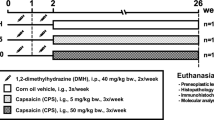Abstract
Current evidence suggests that aberrant cryptfoci (ACF) can be used to evaluate agents for theirpotential colon carcinogenic activity. The aim of thepresent study was to determine whether senna pod extract (SE) itself induces ACF and tumors in the ratcolon or increases the development of ACF and tumorsinduced by azoxymethane (AOM). A daily administration ofSE 10 mg/kg by mouth for 13-28 weeks produced a weak laxative effect but did not itself causethe appearance of ACF or tumors. The numbers of ACF andtumors induced by AOM were, however, increased by a doseof SE (100 mg/kg) able to induce chronic diarrhea over three months. These resultssuggest that SE does not cause the appearance of ACF ortumors in the rat colon nor does it have a promotingeffect when given to rats at a dose that produceslaxation (10 mg/kg), whereas a diarrhogenic dose (100mg/kg) increases the appearance of tumors induced byAOM.
Similar content being viewed by others
REFERENCES
Muller Lissner SA: Adverse effects of laxative fact and action. Pharmacology 47:138–145, 1993
Capasso F, Gaginella TS: Laxative. A Practical Guide. Milan, Springer-Verlag Italia, 1997
Izzo AA, Gaginella TS, Mascolo N, Capasso F: Recent findings on the mode of action of laxatives: The role of platelet activating factor and nitric oxide. Trends Pharmacol Sci 19:403–405, 1998
Izzo AA, Mascolo N, Capasso F: Nitric oxide as a modulator of intestinal water and electrolyte transport. Dig Dis Sci 43:1605–1620, 1998
Brown JP: A review of gene tic effects of naturally occurring flavonoids, anthraquinones and related compounds. Mutat Res 75:243–277, 1980
Bosch R, Friederich U, Lutz WK, Brocker E, Bachmann M, Schlatter C: Investigations on DNA binding in rat liver and in Salmonella and on mutage nicity in the Ames test by emodin, a natural anthraquinone. Mutat Res 188:161–168, 1987
Brusick D, Mengs U: Assessment of the genotoxic risk from laxative senna products. Environ Mol Mutagen 29:1–19, 1997
Kawai K, Mori H, Sigic S, Yoshimi N, Inoue T, Nakamaru T, Nozawa Y, Matsushima T: Genotoxicity in the hepatocyte / DNA repair test and toxicity to liver mitochondria of 1-hydroxyanthraquinone and several dihydroxyanthraquinones. Cell Biol Toxicol 2:457–468, 1987
Mori H, Sugic S, Niwa K, Takahashi M, Kawai K: Induction of intestinal tumors in rats by chrysazin. Br J Cancer 52:781–783, 1985
Mori H, Yoshnimi N, Iwata H, Mori Y, Hara A, Tanaka T, Kawai K: Carcinogenicity of naturally occurring 1-hydroxyanthraquinone in rats: Induction of large bowel, liver and stomach neoplasm. Carcinogenesis 11:799–802, 1990
Siegers CP: Anthranoid laxatives and colorectal cancer. Trends Pharmacol Sci 13:229–231, 1992
Siegers CP, Von Hertberg-Lottin E, Otte M, Scneider B: Anthranoid laxative abuse—a risk for colorectal cancer? Gut 34:1099–1101
Wolfe D, Schmutte C, Westendorf J, Marquardt H: Hydroxyanthraquinone as tumor promoters: Enhancement of malignant transformation of C3H mouse fibroblasts and growth stimulation of primary rat hepatocytes. Cancer Res 50:6540–6544, 1990
Mori H, Mori Y, Tanaka T, Yoshimi N, Sugic S, Kawamori T, Narisawa T: Cell kinetic analysis of the mucosal epithelium and assay of ornithine decarboxylase activity during the process of 1-hydroxyanthraquinone-induced large bowel carcinogenesis in rats. Carcinogenesis 13:2217–2220, 1992
Kleibeuker JH, Cats A, Zwart N, Mulder NH, Hardonk MJ, De Vries EGE: Excessively high cell proliferation in sigmoid colon after an oral purge with anthraquinone glycosides. J Natl Cancer Inst 87:452–455, 1995
Toyota K, Nishikawa A, Furukawa F, Kawanishi T, Hayashi Y, Takahashi M: Cell proliferation induced by laxatives and related compounds in the rat intestine. Cancer Lett 83:43–49, 1994
Pretlow TP, O'Riordan MA, Somich GA, Amini SB, Pretlow TG: Aberrant crypts correlate with tumor incidence in F344 rats treated with azoxyme thane and phytate. Carcinogenesis 13:1509–1512, 1992
Magnuson BA, Carr I, Bird RP: Ability of aberrant crypt foci characteristics to predict colonic tumor incidence in rats fed cholic acid. CancerRes 53:4499–4504, 1993
Pereira MA, Barnes LH, Rossman VL, Kelloffand GV, Steele VE: Use of azoxyme thane-induced foci of aberrant crypts in rat colon to identify potential cancer chemopreventive agents. Carcinogenesis 15:1049–1054, 1994
Bird RP: Role of aberrant crypt foci in understanding the pathogenesis of colon cancer. Cancer Lett 93:55–71, 1995
McLellan EA, Medline A, Bird RP: Sequential analyses of the growth and morphological characteristics of aberrant crypt foci: putative preneoplastic lesions. Cancer Res 51:5270–5274, 1991
Leng-Peschlow E, Odenthal KP, Voderholzer W, Muller-Lissner S: Chronic sennoside treatment does not cause habituation and secondary hyperaldosteronism in rats. Pharmacology 47( suppl 1):162–171, 1993
Fairbairn JW, Saleh MRI: Vegetable purgatives containing anthracene derivatives. A third active glycoside of senna. J Pharm Pharmacol 3:918–925, 1951
Fairbairn JW, Moss MJR: The relative purgative activities of 1,8-dihydroxyanthracene derivatives. J Pharm Pharmacol 22:584–593, 1970
Leng-Peschlow E: Senna its rational use. Pharmacology 44:S1–S52, 1992
Mereto E, Ghia M, Brambilla G: Evaluation of the potential carcinogenesis activity of senna and cascara glycosides for the rat colon. Cancer Lett 101:79–81, 1996
Ames BN, Gold S: Too many rodent carcinogens: mitogenesis increases mutagenesis. Science 249:970–971, 1990
Cohen SM, Ellwin LB: Cell proliferation in carcinogenesis. Science 249:1007–1011, 1990
Westendorf J, Marquardt H, Poginsky B, Dominiak M, Schmidt J, Marquardt H: Genotoxicity of naturally occurring hydroxyanthraquinones. Mutat Res 240:1–12, 1990
Lyden-Sokolowski A, Nilsson A, Sjober P: Two-years carcinogenicity study with sennosides in the rat: emphasis on gastrointestinal alterations. Pharmacology 47( suppl 1):209–215, 1993
De Smet PAGM: An introduction to herbal pharmacovigilance. In Adverse Effect of Herbal Drugs, 3 vol. PAGM De Smet, K Keller, R Hansel, RF Chaudler (eds). Berlin, Springer-Verlag, 1997, pp 1–13
Jacobs EJ, White E: Constipation, laxative use and colon cancer among middle-aged adults. Epidemiology 9:385–391, 1998
al-Dakan AA, al Tuffail M, Hannan MA: Cassiasenna inhibits mutagenic activities of benzo[?]-pyrene, aflatoxina B1, shamma and methyl methansulfonate. Pharmacol Toxicol 77:288–292, 1995
Rights and permissions
About this article
Cite this article
Mascolo, N., Mereto, E., Borrelli, F. et al. Does Senna Extract Promote Growth of Aberrant Crypt Foci and Malignant Tumors in Rat Colon?. Dig Dis Sci 44, 2226–2230 (1999). https://doi.org/10.1023/A:1026696402212
Issue Date:
DOI: https://doi.org/10.1023/A:1026696402212




